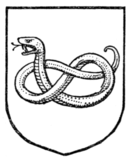CHAPTER XVI
REPTILES
IF armorial zoology is "shaky" in its classification of and dealings with fish, it is most wonderful when its laws and selections are considered under the heading of reptiles. But with the exception of serpents (of various kinds), the remainder must have no more than a passing mention.
The usual heraldic Serpent is most frequently found "nowed," that is, interlaced in a knot (Fig. 483). There is a certain well-understood form for the interlacing which is always officially adhered to, but of late there has manifested itself amongst heraldic artists a desire to break loose to a certain extent from the stereotyped form. A serpent will sometimes be found "erect" and occasionally gliding or "glissant," and sometimes it will be met with in a circle with its tail in its mouth—the ancient symbol of eternity. Its constant appearance in British armory is due to the fact that it is symbolically accepted as the sign of medicine, and many grants of arms made to doctors and physicians introduce in some way either the serpent or the rod of Æsculapius, or a serpent entwined round a staff. A serpent embowed biting its tail occurs in the arms of Falconer, and a serpent on its back in the crest of Backhouse. Save for the matter of position, the serpent of British armory is always drawn in a very naturalistic manner. It is otherwise, however, in Continental armory, where the serpent takes up a position closely allied to that of our dragon. It is even sometimes found winged, and the arms of the family of Visconti, which subsequently came into use as the arms of the Duchy of Milan (Fig. 484), have familiarised us as far as Continental armory is concerned with a form of serpent which is very different from the real animal or from our own heraldic variety. Another instance of a serpent will be found in the arms of the Irish family of Cotter, which are: "Argent, a chevron gules between three serpents proper," and the family of Lanigan O'Keefe bear in one

